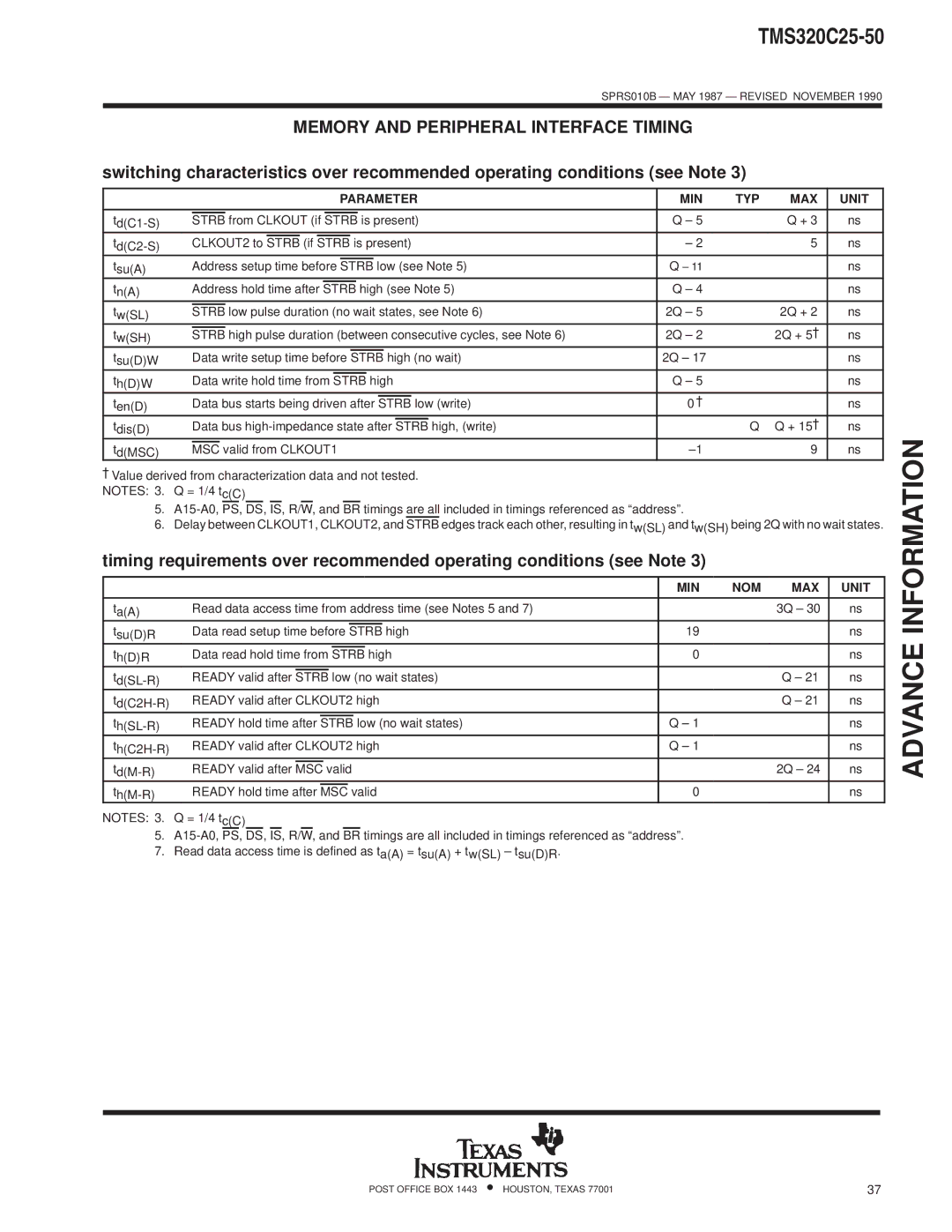
SPRS010B Ð MAY 1987 Ð REVISED NOVEMBER 1990
MEMORY AND PERIPHERAL INTERFACE TIMING
switching characteristics over recommended operating conditions (see Note 3)
|
|
|
|
|
|
|
|
|
| PARAMETER | MIN | TYP | MAX | UNIT | ||||||||||||
|
|
|
|
|
|
|
|
|
|
|
|
|
|
|
|
|
|
|
|
|
|
|
|
|
| |
|
|
|
| from CLKOUT (if |
|
|
|
|
|
| is present) | Q ± 5 |
| Q + 3 | ns | |||||||||||
STRB |
| STRB |
| |||||||||||||||||||||||
CLKOUT2 to |
| (if |
|
|
|
|
|
| is present) | ± 2 |
| 5 | ns | |||||||||||||
STRB | STRB |
|
| |||||||||||||||||||||||
tsu(A) | Address setup time before |
|
|
|
|
|
| low (see Note 5) | Q ± 11 |
|
| ns | ||||||||||||||
STRB |
|
| ||||||||||||||||||||||||
tn(A) | Address hold time after |
|
|
|
|
|
| high (see Note 5) | Q ± 4 |
|
| ns | ||||||||||||||
STRB |
|
| ||||||||||||||||||||||||
tw(SL) |
|
|
| low pulse duration (no wait states, see Note 6) | 2Q ± 5 |
| 2Q + 2 | ns | ||||||||||||||||||
STRB |
|
| ||||||||||||||||||||||||
t |
|
|
| high pulse duration (between consecutive cycles, see Note 6) | 2Q ± 2 |
| 2Q + 5² | ns | ||||||||||||||||||
STRB |
| |||||||||||||||||||||||||
w(SH) |
|
|
|
|
|
|
|
|
|
|
|
|
|
|
|
|
|
|
|
|
|
|
|
|
|
|
tsu(D)W | Data write setup time before |
|
|
|
|
|
| high (no wait) | 2Q ± 17 |
|
| ns | ||||||||||||||
STRB |
|
| ||||||||||||||||||||||||
th(D)W | Data write hold time from |
|
|
|
|
|
| high | Q ± 5 |
|
| ns | ||||||||||||||
STRB |
|
| ||||||||||||||||||||||||
t | Data bus starts being driven after |
|
|
| low (write) | 0 ² |
|
| ns | |||||||||||||||||
STRB |
|
| ||||||||||||||||||||||||
en(D) |
|
|
|
|
|
|
|
|
|
|
|
|
|
|
|
|
|
|
|
|
|
|
|
|
|
|
t | Data bus |
|
| high, (write) |
| Q | Q + 15² | ns | ||||||||||||||||||
STRB |
| |||||||||||||||||||||||||
dis(D) |
|
|
|
|
|
|
|
|
|
|
|
|
|
|
|
|
|
|
|
|
|
|
|
|
|
|
td(MSC) |
| valid from CLKOUT1 | ±1 |
| 9 | ns | ||||||||||||||||||||
MSC |
| |||||||||||||||||||||||||
²Value derived from characterization data and not tested. NOTES: 3. Q = 1/4 tc(C)
5.
6.Delay between CLKOUT1, CLKOUT2, and STRB edges track each other, resulting in tw(SL) and tw(SH) being 2Q with no wait states.
timing requirements over recommended operating conditions (see Note 3)
|
|
|
|
|
|
|
|
|
|
|
|
|
| MIN | NOM | MAX | UNIT |
|
|
|
|
|
|
|
|
|
|
|
|
|
|
|
|
|
|
ta(A) | Read data access time from address time (see Notes 5 and 7) |
|
| 3Q ± 30 | ns | ||||||||||||
tsu(D)R | Data read setup time before |
|
|
| high | 19 |
|
| ns | ||||||||
STRB |
|
| |||||||||||||||
th(D)R | Data read hold time from |
|
|
|
| high | 0 |
|
| ns | |||||||
STRB |
|
| |||||||||||||||
READY valid after |
|
|
|
| low (no wait states) |
|
| Q ± 21 | ns | ||||||||
STRB |
|
| |||||||||||||||
READY valid after CLKOUT2 high |
|
| Q ± 21 | ns | |||||||||||||
READY hold time after |
|
|
|
|
|
| low (no wait states) | Q ± 1 |
|
| ns | ||||||
STRB |
|
| |||||||||||||||
READY valid after CLKOUT2 high | Q ± 1 |
|
| ns | |||||||||||||
READY valid after |
|
|
|
| valid |
|
| 2Q ± 24 | ns | ||||||||
MSC |
|
| |||||||||||||||
READY hold time after |
|
|
|
|
| valid | 0 |
|
| ns | |||||||
MSC |
|
| |||||||||||||||
NOTES: 3. Q = 1/4 tc(C)
5.
7. Read data access time is defined as ta(A) = tsu(A) + tw(SL) ± tsu(D)R.
ADVANCE INFORMATION
POST OFFICE BOX 1443 • HOUSTON, TEXAS 77001 | 37 |
